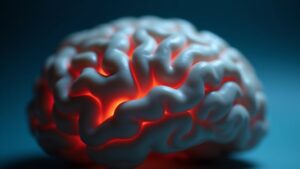Brain aneurysms can be life-altering, with results varying widely based on size, location, and overall health. A brain aneurysm is an abnormal bulge in a brain artery that can remain unnoticed or lead to serious complications if it ruptures. Ruptured aneurysms are emergencies, often leading to severe complications or death, while unruptured ones could go unnoticed for years. Recognizing brain aneurysm symptoms and aneurysm symptoms is crucial, as symptoms may be absent in small, unruptured aneurysms but become severe if rupture or leakage occurs. If any symptoms appear, it is essential to seek immediate medical attention. Factors like smoking, high blood pressure, and family history play a role in rupture risks.
Survivors might confront cognitive changes, fatigue, or emotional shifts, but timely treatment and rehabilitation can enhance recovery. Comprehension of the risks and long-term effects aids in making informed decisions—what happens next could transform everything.
Brain Aneurysm Survival Rates by Type and Severity
While brain aneurysms can be life-threatening, survival rates vary considerably depending on type and severity. Ruptured brain aneurysms are particularly dangerous, with a mortality rate of 25% within 24 hours and 50% within three months. Around two-thirds of survivors experience some degree of brain damage, which can include permanent brain damage and other serious health problems. Ruptured brain aneurysm symptoms often include the sudden onset of the worst headache ever experienced, along with other signs such as nausea, vomiting, stiff neck, and loss of consciousness.
An unruptured brain aneurysm, however, poses a lower immediate threat—small aneurysms are often asymptomatic, and those smaller than 10 mm have a rupture risk of just 0.8-1.5% over nearly four years. Larger posterior aneurysms exceeding 25 mm carry a 50% rupture risk within five years, emphasizing the role of aneurysm size in consequences.
Children fare better, with an 80% survival rate after rupture. Monitoring and prompt intervention can profoundly impact the long-term prognosis for both ruptured and unruptured cases. Most aneurysms do not rupture and may never cause symptoms.
Key Risk Factors for Brain Aneurysm Rupture and Complications
Several factors can notably increase the likelihood of a brain aneurysm rupture, turning a silent threat into a life-threatening emergency. Common risk factors include high blood pressure, smoking, genetics, infections, head trauma, and brain tumors, all of which contribute to increased risk of aneurysm formation and rupture. The size and location of the aneurysm play a critical role—larger ones (over 25 mm) have a 50% rupture risk within five years. High blood pressure and smoking further strain blood vessel walls, weakening the artery wall and blood vessel wall, especially in major arteries at the base of the brain, raising rupture risks. Thin tissues in these vessel walls can also contribute to aneurysm formation. A history of previous ruptures also worsens prognosis. Managing these risk factors through lifestyle changes and regular checkups can improve prospects.
Risk Factor | Impact on Rupture Risk | Prevention Tips |
|---|---|---|
Large size (>25mm) | High (50% in 5 years) | Regular imaging checks |
Smoking | Doubles risk | Quit smoking if you smoke |
High blood pressure | Weakens vessel walls | Medication, diet control |
Certain locations | Varies by artery | Specialist evaluation |
Early identification and control of these factors can reduce complications and aid recovery.
Long-Term Effects and Recovery After a Brain Aneurysm
Brain aneurysms, whether treated or ruptured, often leave lasting effects that shape daily life long after the initial event. Survivors can face a range of long-term effects, from physical challenges to cognitive and emotional shifts.
Cognitive Impact: Memory deficits, especially with recalling details or planning ahead, are common. Some improve over time, but others persist.
Personality Changes: Emotional instability, reduced self-control, or anxiety may arise, particularly after a subarachnoid hemorrhage.
Physical Challenges: Chronic issues like fatigue, headaches, or coordination problems can persist, requiring ongoing adjustments. Aneurysms pressing on brain tissue can lead to various neurological health problems, including pain, weakness, or other complications.
Lifestyle Adjustments: Managing unruptured brain aneurysms often means quitting smoking, controlling blood pressure, and reducing the risk of rupture.
Recovery time varies, but patience and support play key roles in adapting to these changes.
Treatment Options and Their Impact on Prognosis
Aneurysm treatment includes several options, each tailored to the patient’s specific condition.
Treatment | Key Benefit |
|---|---|
Clipping Surgery | High success rate for large aneurysms |
Microvascular Clipping | Open brain surgery that uses a small metal clip to block blood flow to the aneurysm, preventing rupture |
Coiling | Less invasive, quicker recovery |
Endovascular Coiling | Minimally invasive procedure that blocks blood flow into the aneurysm by deploying tiny coils |
Endovascular Treatment | Minimally invasive alternative, suitable for patients with high surgical risk or complex aneurysms |
Flow Diversion | Newer option for complex cases; works by redirecting blood flow away from the aneurysm |
Choosing the right approach depends on aneurysm size, location, and patient health. Prompt intervention often leads to superior results.
Endovascular coiling is a minimally invasive procedure that blocks blood flow into the aneurysm, helping to prevent rupture.
Lifestyle Changes and Prevention Strategies
While medical treatments like clipping, coiling, or flow diversion address existing aneurysms, managing risk factors before problems arise plays an equally critical role. Lifestyle changes can significantly reduce brain aneurysm risk by targeting key contributors.
- Control high blood pressure: A balanced, low-sodium diet and regular exercise help maintain healthy blood pressure, reducing strain on blood vessels.
- Quit smoking: Smoking weakens artery walls, increasing rupture risk—quitting lowers this danger.
- Limit alcohol: Excessive drinking raises blood pressure; moderation supports vascular health.
- Prioritize medical checkups: Regular monitoring detects initial warning signs, enabling timely prevention.
It is important to recognize that aneurysm leaks, including brain aneurysm leaks and leaking aneurysm, can sometimes occur before a major rupture. These may present as a sentinel bleed—a small leak of blood into the brain that acts as a warning sign. Symptoms such as sudden, severe headaches may indicate a sentinel bleed or leaking aneurysm and require immediate medical attention to prevent catastrophic bleeding.
Small, consistent adjustments—like walking daily or choosing nutrient-rich foods—can make a meaningful difference. Though genetics play a role, proactive choices empower individuals to lower their risk and protect brain health.
Monitoring and Follow-Up Care for Survivors
After surviving a brain aneurysm, consistent monitoring and follow-up care become essential for long-term recovery and safety. Regular imaging scans, typically every 6-12 months, help detect aneurysm growth or new aneurysm formation. Monitoring is important for detecting changes in cerebral aneurysm, cerebral aneurysms, and intracranial aneurysm, as well as assessing blood flowing through the brain’s vessels to evaluate risk.
Long-term follow-up with a specialist checks for neurological deficits or complications. Complications can include hemorrhagic stroke, ischemic stroke, and cerebral vasospasm. Rehabilitation, like physical or speech therapy, can be needed to regain function. Lifestyle changes, including blood pressure management and smoking cessation, lessen recurrence risks.
Emotional support, such as counseling, aids in coping with the aftermath. Survivors should stay vigilant about symptoms and attend all scheduled appointments. These steps guarantee better health outcomes and peace of mind. Monitoring isn’t just precautionary—it’s a proactive way to safeguard against future risks while supporting recovery.
Bottom Line
Brain aneurysms are serious but manageable with the proper care. While ruptured aneurysms have a 50% mortality rate within three months, timely identification and treatment can significantly enhance results. Surprisingly, about 1 in 50 people unknowingly have an unruptured aneurysm. Staying proactive with monitoring and healthy habits can make all the difference—your future self will appreciate it.





